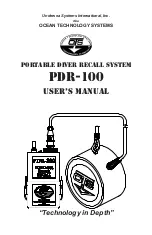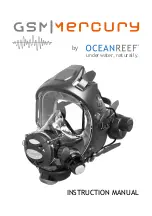
13
R
C
Load
L
N
External
AC supply
Relay Contacts
NC C NO
Load
+
–
External
DC supply
Relay Contacts
A – AC Applications
B – DC Applications
NC C NO
Diode
3
ELECTRICAL CONNECTIONS…
3.2
Connections, General
Warning.
The power supply earth (ground)
must
be connected to ensure safety to personnel, reduction of the effects of RFI and
correct operation of the power supply interference filter.
Information.
•
Earthing (grounding) –
stud terminal(s) is fitted to the transmitter case for bus-bar earth (ground) connection – see Fig. 3.1
or 3.5.
•
Cable lengths
– The cable length between the turbidity sensor unit and the electronics unit is provided as ordered, and
terminated at the sensor unit. The cable can be shortened or lengthened as appropriate to the installation.
•
Cable routing
– always route the signal cable and mains-carrying/relay cables separately, ideally in earthed (grounded) metal
conduit.
Ensure that the cables enter the transmitter through the glands nearest the appropriate screw terminals and are short and
direct. Do not tuck excess cable into the terminal compartment.
•
Cable glands & conduit fittings
– ensure a moisture-tight fit when using cable glands, conduit fittings and blanking plugs/
bungs (M20 holes). The M16 glands ready-fitted to wall-mounted instruments accept cable of between 4 and 7 mm diameter.
•
Relays
–the relay contacts are voltage-free and must be appropriately connected in series with the power supply and the
alarm/control device which they are to actuate. Ensure that the contact rating is not exceeded. Refer also to Section 3.2.1 for
relay contact protection details when the relays are to be used for switching loads.
•
Retransmission output
– Do not exceed the maximum load specification for the selected current retransmission range – see
SPECIFICATION,
Section 8.
Since the retransmission output is isolated the –ve terminal
must
be connected to earth (ground) if connecting to the isolated
input of another device.
3.2.1
Relay Contact Protection and Interference Suppression – Fig. 3.3
If the relays are used to switch loads on and off, the relay contacts can become eroded due to arcing. Arcing also generates radio
frequency interference (RFI) which can result in instrument malfunction and incorrect readings. To minimize the effects of RFI, arc
suppression components are required; resistor/capacitor networks for AC applications or diodes for DC applications. These
components can be connected either across the load or directly across the relay contacts. On 4600 Series instruments the RFI
components must be fitted to the relay terminal block along with the supply and load wires – see Fig 3.3
For
AC applications
the value of the resistor/capacitor network depends on the load current and inductance that is switched. Initially,
fit a 100R/0.022
FRC suppressor unit (part no. B9303) as shown in Fig. 3.3A. If the instrument malfunctions (incorrect readings) or
resets (display shows 88888) the value of the RC network is too low for suppression – an alternative value must be used. If the correct
value cannot be obtained, contact the manufacturer of the switched device for details on the RC unit required.
For
DC applications
fit a diode as shown in Fig. 3.3B. For general applications use an IN5406 type ( 600 V peak inverse voltage at
3A – part no. B7363).
Note.
For reliable switching the minimum voltage must be greater than 12 V and the minimum current greater than 100 mA.
Fig. 3.3 Relay Contact Protection
Summary of Contents for 4670 Series
Page 1: ...Turbidity Systems 4670 Series User Guide IM 4670_13 ...
Page 49: ...47 NOTES ...
Page 50: ...48 NOTES ...
















































